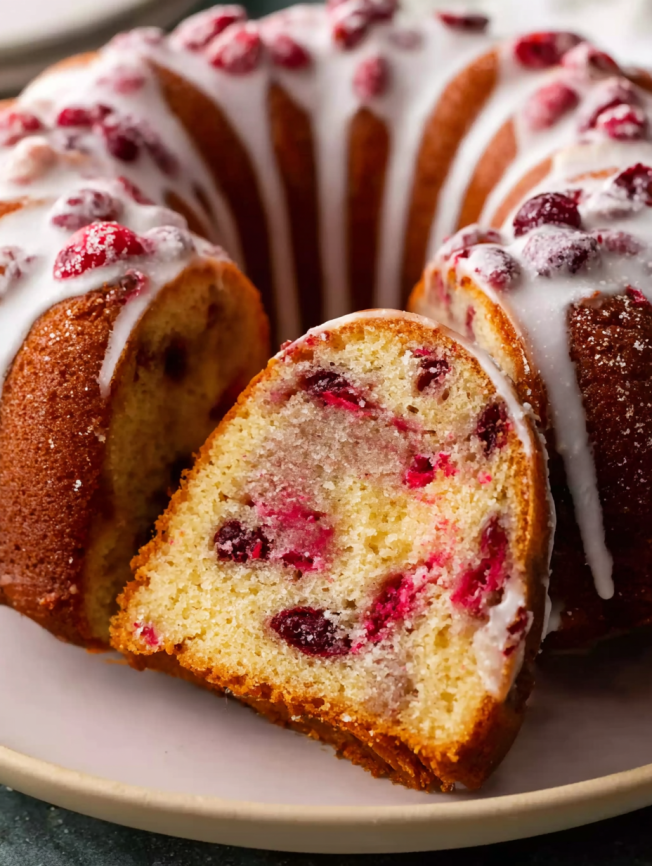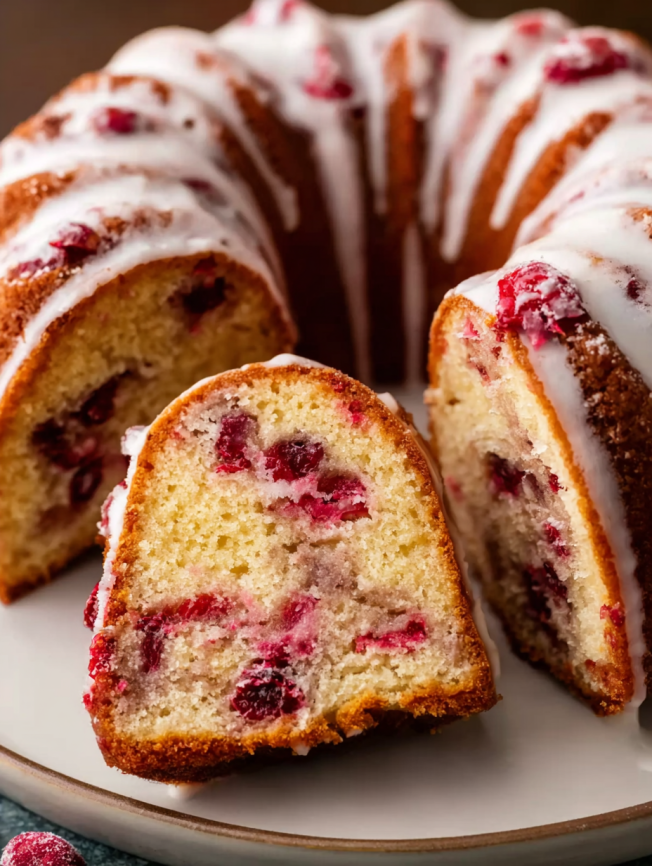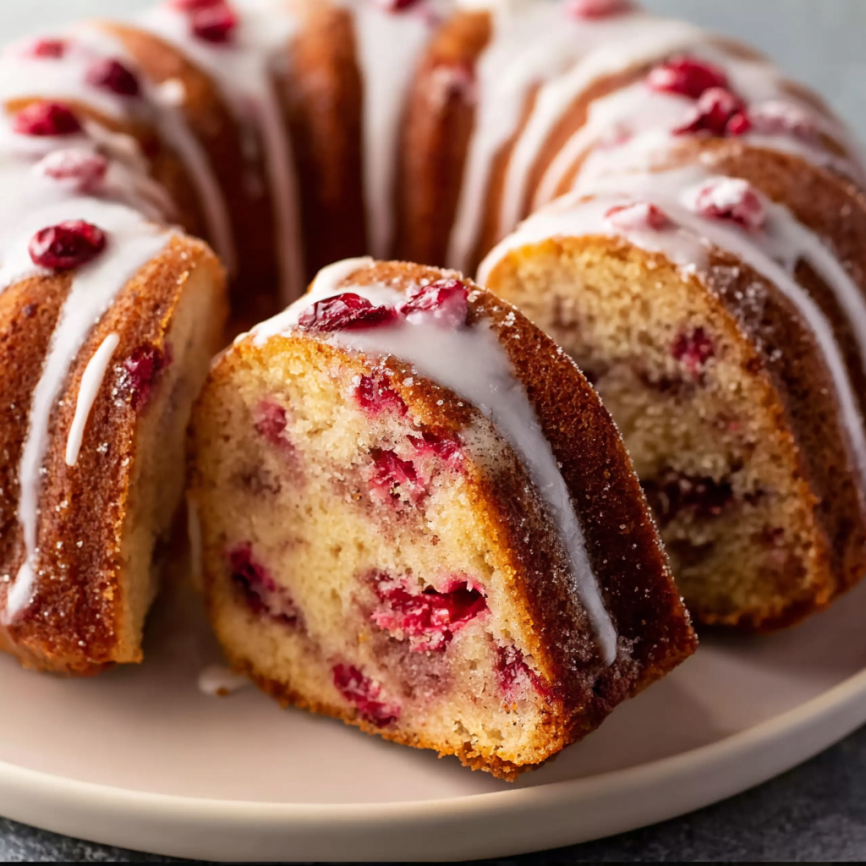Prep Time: 15 minutes | Cook Time: 65 minutes | Total Time: 5 hours, 30 minutes | Serves: 12
A Cake That Defines the Season
There’s something undeniably magical about the moment this cranberry orange Bundt cake emerges from the oven, filling my entire kitchen with the warm, citrusy aroma that instantly signals the holidays have arrived. This recipe holds a special place in my heart—it’s the cake that transformed me from a nervous baker into someone confident enough to bring dessert to family gatherings.
The first time I made this cake, I was skeptical about the combination of tart cranberries and bright orange flavors. However, that initial bite revealed perfect harmony: buttery brown sugar sweetness balanced by tangy fruit, all enhanced by a surprise ribbon of cinnamon-sugar running through the center. Years later, this remains my most requested recipe, equally at home on holiday tables and casual weekend brunches.
Why This Cake Will Steal Every Show
Spectacular Visual Impact
Bundt cakes possess an inherent elegance that transforms any gathering into something special. This particular version showcases jewel-toned cranberries against a golden backdrop, creating a stunning centerpiece that photographs beautifully and impresses guests before they even take their first bite.
Perfect Flavor Balance
The combination of brown sugar’s caramel notes, fresh orange’s brightness, and cranberries’ tartness creates sophisticated complexity without overwhelming any single taste. Meanwhile, the hidden cinnamon-sugar swirl adds warmth and depth that surprises with each slice.
Foolproof Success Formula
Despite its impressive appearance, this recipe forgives minor timing variations and mixing inconsistencies. The generous butter content ensures moisture, while the careful balance of leavening agents prevents common Bundt cake pitfalls like tunneling or dense texture.
Make-Ahead Convenience
Holiday entertaining becomes significantly easier when dessert is already prepared. This cake actually improves with time as flavors meld, making it perfect for advance preparation during busy celebration periods.
Essential Ingredients
Cake Foundation
- 3 cups (375g) all-purpose flour – spooned and leveled for accuracy
- 2½ teaspoons baking powder – ensures proper rise and light texture
- 1¼ teaspoons salt – enhances all flavors and balances sweetness
- 1½ cups (340g) unsalted butter – softened to room temperature for smooth creaming
- 1 cup (200g) packed brown sugar – light or dark varieties both work beautifully
- ½ cup (100g) granulated sugar – provides structure and additional sweetness
- 2 tablespoons fresh orange zest – essential for authentic citrus flavor
Moisture and Richness Components
- 5 large eggs – at room temperature for optimal incorporation
- ½ cup (120g) full-fat sour cream – creates tender crumb and tangy depth
- 2 teaspoons pure vanilla extract – enhances overall flavor complexity
- ½ cup (120ml) milk – at room temperature for smooth mixing
- ¼ cup (60ml) fresh orange juice – intensifies citrus presence
Fruit and Filling Elements
- 1¾ cups (220g) cranberries – fresh or frozen work equally well
- ⅔ cup (135g) packed brown sugar – for the cinnamon swirl filling
- 2 teaspoons ground cinnamon – adds warmth and aromatic spice
Orange Glaze Finish
- 1½ cups (180g) confectioners’ sugar – creates smooth, glossy coating
- 3-4 tablespoons (45-60ml) fresh orange juice – adjusts consistency and flavor intensity

Step-by-Step Instructions
Preparation Essentials
Begin by preheating your oven to 350°F (177°C) and thoroughly greasing a 10-inch Bundt pan. Proper pan preparation is crucial—use butter or baking spray, ensuring every groove and crevice receives coverage. This attention to detail prevents the heartbreak of a cake that sticks during removal.
Creating the Perfect Batter
Dry Ingredient Foundation
In a large bowl, whisk together flour, baking powder, and salt until evenly distributed. This preliminary mixing ensures consistent leavening throughout the finished cake and prevents pockets of concentrated baking powder.
Creaming for Success
Using either a handheld or stand mixer fitted with paddle attachment, cream the softened butter, brown sugar, granulated sugar, and fresh orange zest together for approximately three minutes. The mixture should appear light, fluffy, and significantly increased in volume—this creaming process incorporates air for optimal texture.
Add eggs one at a time, followed by sour cream and vanilla extract. Beat on medium speed until just combined, scraping bowl sides and bottom as needed. Don’t worry if the mixture appears slightly curdled at this stage—this appearance is completely normal and will resolve when dry ingredients are incorporated.
Final Assembly
Pour the flour mixture into the wet ingredients, then add milk and fresh orange juice simultaneously. Beat on medium speed until the batter achieves complete smoothness and uniform consistency. The finished batter should appear thick yet silky, coating mixing spoons without being stiff.
Gently fold in cranberries using a spatula or mixer on lowest speed. Distribute them evenly throughout the batter for consistent fruit distribution in every slice.
Creating the Cinnamon Swirl
In a small bowl, combine brown sugar and cinnamon, mixing until evenly blended. This simple filling creates a delightful surprise layer that adds visual appeal and flavor complexity to each serving.
Assembly and Baking Technique
Pour exactly half the batter into your prepared Bundt pan, spreading evenly with a spatula. Sprinkle the cinnamon-sugar mixture over this layer, keeping it away from the pan edges to prevent sticking during removal. Cover with remaining batter, ensuring complete coverage of the filling layer.
Bake for 55-70 minutes, testing doneness with a toothpick inserted into the thickest section. The tester should emerge clean with perhaps a few lightly moist crumbs. This substantial cake may require the full baking time, so don’t worry if it seems longer than expected.
Critical Cooling Process
Remove the finished cake from the oven and allow it to cool in the pan for exactly one hour. This timing is crucial—removing too early risks breakage, while waiting too long makes removal difficult as the cake contracts and grips the pan.
After one hour, confidently invert the cake onto a wire cooling rack or serving plate. Allow complete cooling before glazing, as warm cake will cause the glaze to become too thin and runny.
Serving Suggestions
Elegant Presentation Options
Drizzle the orange glaze in artistic patterns over the completely cooled cake, allowing some to pool in the decorative grooves while others cascade down the sides. For special occasions, garnish with sugared cranberries, fresh orange zest, or even edible flowers for stunning visual impact.
Slice using a sharp serrated knife with gentle sawing motions to prevent crushing the delicate crumb. Clean the knife between cuts for professional-looking portions that showcase the beautiful interior swirl.
Perfect Pairing Ideas
This cake pairs beautifully with freshly brewed coffee, spiced tea, or even champagne for celebratory occasions. Serve alongside whipped cream or vanilla ice cream for those who prefer extra richness, though the cake stands perfectly on its own.
Creative Recipe Variations
Seasonal Adaptations
Transform this base recipe for different occasions by substituting dried cherries for cranberries during summer months, or adding chopped pecans for autumn gatherings. Lemon zest and blueberries create a delightful spring variation that maintains the same spectacular results.
Glaze Alternatives
Experiment with different glaze flavors by substituting lemon juice for orange, or create a cream cheese glaze by mixing softened cream cheese with confectioners’ sugar and citrus juice for tangy richness.
Mix-In Variations
Consider adding chopped walnuts or pecans to the batter for textural interest, or incorporate a tablespoon of poppy seeds for subtle crunch and visual appeal.
Make-Ahead Tips
Advanced Preparation Strategy
This cake actually improves with overnight resting as flavors develop and meld together. Prepare the cake completely except for glazing, wrap tightly, and refrigerate for up to two days. Bring to room temperature before adding glaze and serving for optimal texture and flavor.
Freezing Guidelines
The unglazed cake freezes exceptionally well for up to three months when wrapped properly in plastic wrap and aluminum foil. Thaw overnight in the refrigerator, then bring to room temperature before glazing. This makes it perfect for holiday menu planning and stress-free entertaining.
Storage Optimization
Store leftover cake covered at room temperature for up to two days, or refrigerate for extended freshness up to one week. The orange glaze may absorb slightly into the cake during storage, but this only enhances the overall flavor integration.
Essential Notes
Room Temperature Success
All dairy ingredients and eggs should reach room temperature before mixing begins. Cold ingredients don’t incorporate smoothly, potentially creating lumps or uneven texture in the finished cake. Plan ahead by removing these items from refrigeration 30-60 minutes before baking.
Fresh Citrus Importance
Always use fresh orange juice and zest rather than bottled alternatives. The difference in flavor intensity and brightness is remarkable, elevating this cake from good to extraordinary. Since you’re zesting oranges anyway, using their juice ensures optimal freshness and flavor.
Cranberry Flexibility
Fresh, frozen, or even dried cranberries work successfully in this recipe. Frozen cranberries should be used directly from the freezer without thawing to prevent excess moisture and color bleeding. Dried cranberries provide concentrated sweetness and chewy texture that some prefer.
Pan Preparation Critical
Proper Bundt pan preparation cannot be overemphasized. Use generous amounts of butter or baking spray, paying special attention to intricate details and crevices. Consider dusting with flour after greasing for extra insurance against sticking.

Frequently Asked Questions
Why did my cake stick to the pan?
Insufficient pan preparation is the most common cause of sticking. Ensure every surface receives thorough greasing, including all decorative details. Additionally, timing matters—removing the cake too early or too late can cause adherence issues.
Can I substitute Greek yogurt for sour cream?
Plain Greek yogurt works excellently as a sour cream substitute, providing similar moisture and tang. Use the same measurement and ensure it’s at room temperature for optimal mixing results.
What if my batter looks curdled after adding eggs?
This appearance is completely normal when combining room temperature eggs with butter-sugar mixture. The texture will smooth out when flour and liquids are incorporated, so don’t worry about this temporary appearance.
How do I know when the cake is perfectly done?
Insert a toothpick into the thickest part of the cake—it should emerge clean or with just a few moist crumbs. This large cake may take the full 70 minutes, so be patient and test regularly during the final 10 minutes of baking.
Can I make this cake without the cinnamon swirl?
Absolutely! Simply layer all the batter into the pan without the filling mixture. The cake will still be delicious, though you’ll miss the lovely surprise layer and additional flavor dimension.
Why is my glaze too thick or thin?
Orange juice consistency varies, affecting glaze texture. Start with 3 tablespoons of juice and add more gradually for thinner consistency, or incorporate extra confectioners’ sugar to thicken as needed.
How far ahead can I make this for a party?
The cake maintains peak quality for 2-3 days when stored properly. For best results, make the cake 1-2 days in advance and add glaze on the day of serving for optimal appearance and texture.
What’s the best way to transport this cake?
Use a cake carrier with a tight-fitting dome, or cover loosely with plastic wrap supported by toothpicks to prevent glaze damage. Transport on a level surface and avoid temperature extremes that might affect the glaze consistency.

